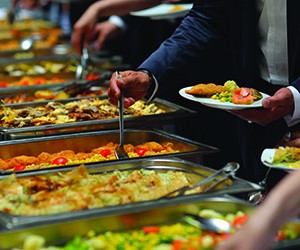No matter what the budget, there are time-honored best practices that can help planners stretch their dollars and cut down on waste. Here are a few tips from the experts.
Plate or Buffet?
While it’s sometimes assumed that a buffet is a cheaper option than a plated meal, nothing could be further from the truth, according to F&B expert and industry veteran Patti Shock.
“The buffet is more expensive because the kitchen has to prepare surpluses of everything,” she says. “You don’t know what people are going to choose, so you have to make sure there is plenty of everything. And there’s no portion control. So the plated dinner will be cheaper.”
There are times though when the buffet will be the better option, she adds.
“A buffet can be good in the morning, when people are straggling in for breakfast at different times,” she says. “People don’t want to sit and wait at the table for others at breakfast. They want their coffee now.”
Limited Choices
While a plated meal can mean less choice than a buffet, planners still need to provide some choice. How much choice is enough?
“Three choices are usually best—you want to have one vegetarian choice and two proteins,” Thomas Pitchford of Pitch Perfect Events says. “Too many choices will simply be confusing for people. Don’t have more than four or five.”
When the choices are determined, it’s essential to ask attendees to indicate their selections before the meeting, he adds.
“If we know in advance what people are having, the hotel can purchase accordingly and doesn’t have to have everything on hand,” he says. “You don’t end up paying for the overage.”
Use Your History
When it comes to knowing how much or how little food to order, there’s nothing like keeping track of a meeting’s history, Shock says.
“While consumption charts are available, the best predictor is your past history,” she says. “You should be making notes from year to year. If you do, you won’t forget that there was a half a tray of cubed cheese left over. You’ll know to order half as much this year.”
Play Piggyback
When he’s faced with a tight budget, Pitchford uses a “piggyback” strategy by consulting with the hotel or venue chef about what foods are being purchased for other events happening at the same time. If the items are right for his group, he’ll ask the chef to purchase the same foods for his group.
“If the chef can buy in bulk, it’s cheaper and also means that the chef doesn’t have to recreate an entire new menu,” he says.




